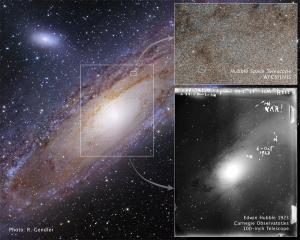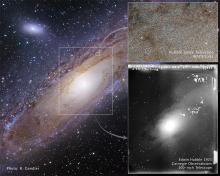Astounding Star [1]
It’s not often that a single star transforms our view of the universe. But it happened with a star that was photographed 100 years ago tonight. The star proved that there’s more to the universe than just the Milky Way Galaxy — much more.
The star is known today as M31-V1. It’s in M31, the Andromeda Galaxy. A century ago, M31 was called the Andromeda Nebula. Many astronomers thought it was a mote of matter inside the Milky Way. Others thought it was a separate galaxy — an “island universe” of billions of stars.
On the night of October 5th of 1923, Edwin Hubble snapped a picture of a small segment of M31. He identified three stars that had grown much brighter since the last time he looked at them. Follow-up observations showed that one star’s brightness changed from night to night.
That star was a Cepheid — a supergiant star that’s unstable. It pulses in and out like a beating heart. The duration of the pulses revealed the star’s true brightness. And from that, Hubble calculated its distance — a million light-years. Studies of other Cepheids confirmed the distance. So M31 had to be well beyond the Milky Way — vastly expanding our understanding of the universe.
Modern observations put the distance to M31 at two-and-a-half million light-years. And the galaxy is visible to the unaided eye. Under dark skies, it looks like a faint smudge of light, in the north-northeast at nightfall.
Script by Damond Benningfield
Keywords:
- Andromeda Galaxy, M31 [3]
- History [4]
- History of Astronomy [5]
- Hubble, Edwin [6]
- Variable Stars [7]


